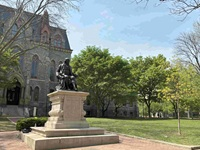Speaker
Description
We present an exploratory idea that allows effective fabrication of large-area amorphous selenium detectors with field shaping multiwell structure. Field shaping multi-well structures consists of well-regions produced by Frisch grids within the amorphous selenium vertical architecture. Such structures are usually produced using complex nanofabrication methods to create pillars on a substrate with metallic films on top of the pillars. The Frisch grids allow to concentrate the field lines within the well region thereby confining the avalanche multiplication process in the well, and thus improves the timing resolution and charge collection efficiency. Such a detector has the promise to reach picosecond timing resolution as shown by a few recent demonstrations. However, the depth over which the avalanche multiplication can occur within the well is limited since the conventional line-of-sight Se deposition clogs the well for depths exceeding ~2 µm. We propose a laminated multi-well architecture that forms the wells by mating two plates rather than filling deep cavities. Each plate carries the Frisch grid metal electrodes on top edge and the high-k hole-blocking dielectric on all sides. After separate, uniform a-Se deposition on largely open surfaces, plates are aligned (≤±0.5 µm) and perimeter-bonded, if possible, at room temperature with precautions to keep adhesive out of the active area. The bottom electrode is now grown, completing the multi-well structure. We believe such a laminated gap will yield fields necessary for avalanche and makes a large area multi-well avalanche detector a reality.

